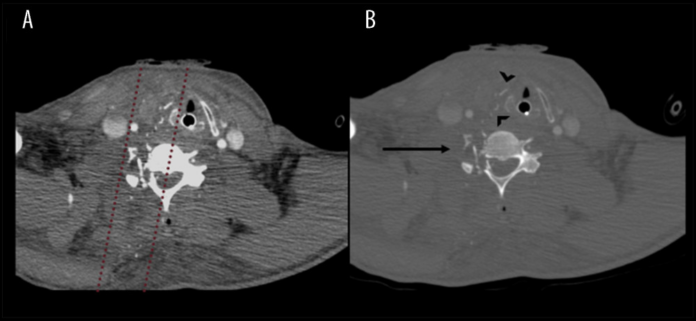
Hypoperfusion/Devascularization of thyroid gland
This article describes the case of a 26-year-old male patient with thyroid gland hypoperfusion/devascularisation after a gunshot wound. The patient was transferred to the trauma centre after multiple gunshot wounds. Physical examination showed a wound through the base of the patient’s neck to the right of the midline. Clinically, entry and exit wounds both were identifiable.
Investigations and diagnosis
For further evaluation, doctors advised a CT angiogram (CTA) which showed bullet paths at the level of the C6 vertebral body. In addition, a complex, comminuted and distracted fracture of the C6 was identified. An underlying, comminuted and distracted fracture was seen in C6, involving the right lateral vertebral body, right lamina, right facet joint, right pedicle and right transverse process. A partial obliteration of the right C6 foramen transversarium was also seen including a post-traumatic injury to the right vertebral artery. The injuries were likely related to post-traumatic dissection with associated thrombosis. A fracture of the right lamina of the thyroid cartilage was also noted anterior to the bullet’s path. Other findings included right thyroid love enlargement/oedema, with an asymmetric decrease in enhancement of the lobe. There were also signs of diffuse subcutaneous oedema in the overlying tissues of the neck.
For further evaluation, doctors advised a maximum-intensity-projection (MIP) angiography of the vascular supply of the thyroid gland. Findings showed a decrease in calibre near the posterior glandular branch of the right superior thyroid artery. These findings are consistent with vasospasm and not an arterial injury. This supposedly led to the hypoperfusion/devascularisation of the thyroid lobe’s upper pole.
Chest and abdomino-pelvic CT scans performed on the patient’s admission to the trauma centre confirmed the diagnosis. A chest CT with IV contrast further showed moderate pulmonary interstitial oedema. Examination findings also showed extensive diffuse submucosal oedema of the patient’s stomach, a large bowel and mesenteric oedema. The findings led to a need of aggressive fluid hydration.
The patient also required mechanical ventilation given the extent of the gunshot wounds. There was no evidence of tracheal injury. Unfortunately, the patient condition further deteriorated and he passed away 3 days after admission.
Source: American Journal of Case Reports



